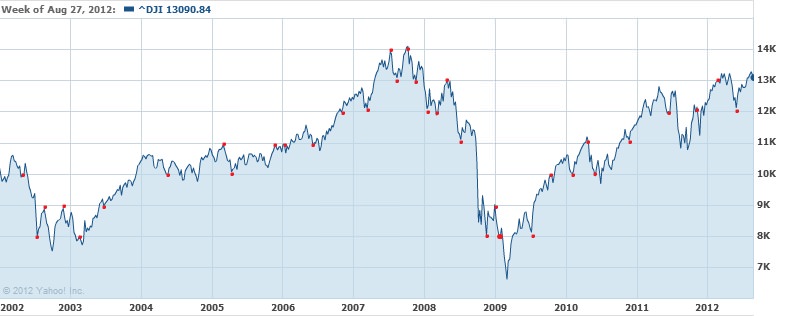BroadVision’s Dead Pump Bounce
BroadVision Inc (NASDAQ:BVSN) was up earlier this year due to a pump and dump scam successful investor relations campaign. Just as with market bubbles, if the fundamentals of a company are weak, what goes up must eventually come down. ‘Eventually’ being the operative word. When BVSN broke out above $10 back in mid-December, nobody knew it would eventually make a high of $56.46, showing once again that prices can rise the most in exactly the places where fundamentals are weakest.
Last Wednesday, out of the blue, BVSN down far off its highs to the mid-$8 level ran big (1), to the upper $11, to close that day in the high $10’s. The next day, it peaked at $11.96 only to fall sharply in the afternoon going red on the day (2). Taking this as a sign of weakness, I entered into a short position, but the stock managed to come back some and close slightly positive at $11. I could see the next morning it wasn’t quite ready to break down, so I covered for a loss (3) avoiding the potential for further losses as the stock ran back up to $11.50.

1) Run-up, 2) Sign of weakness, 3) Not breaking down, 4) Fading, no shares, 5) Fading, found shares, 6) Covered
There was clear fading in the afternoon, and so I tried to re-short (4), but no shares were available through my broker, so I had to just sit on my hands. Monday started low but spiked real fast in the morning. By afternoon, it was clear that both the volume was fading and the price was falling, a great indicator of an upcoming drop (5). Luckily, my broker did have shares this time, so I shorted again, an even larger position since everything was in my favor: stock was red on the day, close to making a new day’s low, fading volume, and coming off of a spike.
Today, I covered my position (6) even though it’s likely the stock had another dollar to drop. My reasons for playing it safe are as follows: First, stormy weather was causing problems with my internet connection, and this was affecting my trading platform. Second, I rarely like holding for more than 2 days. Third, a lot of traders don’t like the risks involved in holding a short position over the weekend, so Friday squeezes are common, and sometimes it even happens on a Thursday. The later in the week I hold, the more probable a price spike becomes. And fourth, given the trading history of BVSN, after 4 red days, a green day is due.
Aside from the price action, what’s worth mentioning is how I traded. I made two trades on this. On one I lost money, on the other I made money. You might be tempted to say that’s 50/50, no better odds than tossing a coin. But on net between these two trades, I’m up about $300 on a $3500ish investment, for a roughly 8.5% gain in less than one week. If only I could do that every week. 8.5% per week, compounded, would mean making 70 times my position (or close to a quarter million dollars) by year’s end!
So 50/50 really isn’t that bad if you can: Spot opportunities, Have a plan, Manage your risks, and Stay disciplined and humble. I believe technical analysis and the Austrian perspective will not only give you a better understanding of the markets in general, but make you better on those four specific points.


Recent Comments